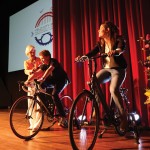The meeting brought together the American Society of Naturalists (ASN), the Canadian Society for Ecology and Evolution (CSEE), the European Society for Evolutionary Biology (ESEB), the Society for the Study of Evolution (SSE), and the Society of Systematic Biologists (SSB) at the Ottawa Convention Centre on July 6-10. More than 2,400 scientists from 45 countries attended.
Challenges
The principal meeting planner for the event, Chuck Shouwerwou, CMP, president of ConferSense Planners, had the task of creating a cohesive environment for five of the world’s largest academic organizations, each with unique missions and cultures, across one large event. (Read our Pre Con profile of the First Joint Congress at convn.org/ evolution-pre-con.) In addition to the main conference, there were numerous satellite events for each of the participating groups, giving Shouwerwou a number of gaps to bridge.
Over the course of four days, there were approximately 1,300 presentations covering the latest news and developments in the evolutionary sciences, including one breakthrough in which geneticists evolved a species of fruit fly with the ability to count. Shouwerwou was able to broadcast the talks via a new automated audiovisual system, from AVWTELAV, that projected them onto large screens in meeting rooms throughout the convention center, with anywhere from 90 to 500 attendees in each room. “It’s a new concept, [a] very new system,” Shouwerwou said. “We were able to program all the presentations through one command system. There were speakers every 15 minutes, so when you have that many talks in that many rooms, this centralized system makes it run smoothly.”
The tool was vital for the congress, which drew 2,440 attendees, a record-breaking number for the center, which opened in April 2011. Shouwerwou said: “It was the largest city-wide meeting to date with the new convention center.”
The only hiccup came when the wireless-Internet connection was hacked and attendees had inconsistent access to the web for about three days, putting a wrench in the paperless program that provided online itineraries and a smartphone app. “We had limited complimentary Internet at the event before the glitch,” Shouwerwou said. “So we threw it out to everyone for free to apologize.”
Fortunately the AV system broadcasting the presentations was internal, independent from the Wi-Fi and thus protected from the hacking. “It didn’t affect the presentations at all,” Shouwerwou said. “In the end, it worked beautifully.”
Initiatives
Despite Shouwerwou’s small team, two university professors who championed bringing the conference to Ottawa, and tight budget, he was determined to impress. The scientific poster sessions, which are usually “dry, boring affairs,” according to Shouwerwou, were held as evening cocktail receptions. This made a productive exchange of information and no-pressure socializing a breeze, and helped result in more than a 90-percent turnout. “With that many people in-house and it being a fairly new center, everything flowed really well,” Shouwerwou said. “The Ottawa Convention Centre staff went above and beyond, with planning the food-and-beverage stations, the technology, with everything.”
Next year’s congress will be held in Utah, as part of a rotation that moves it between Europe and North America every few years. The Evolution conference, the precursor to this year’s co-located event, involving ASN, SSE, and SSB, hadn’t met in Canada in more than 10 years, and Shouwerwou was astounded by how well things worked out. He said: “I’d have a hard time coming up with a negative thing to say about the congress itself.”
The passion surrounding the landmark event spilled onto the streets of Ottawa when about 2,000 students, professors, and scientists snaked their way up to Parliament Hill on the final day of the conference to stage a mock funeral procession, mourning the “Death of Evidence,” in protest of government funding cuts to scientific research.
For more information: confersense.ca/evolution2012
Convene’s Pre-Con/Post-Con series asks meeting planners about their challenges and how they intend to address them (Pre-Con), and then circles back around after the meeting has occurred (Post-Con) to see how well they worked out.



